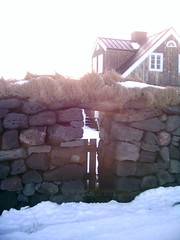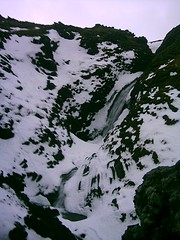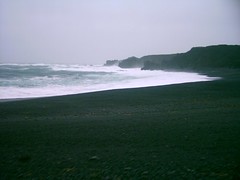Winter in Iceland
Guidebooks aren't much use in sorting out what's available in Iceland in the winter. Both the Rough Guide and the Lonely Planet treat anything from September to May as an afterthought; sometimes they give opening and closing dates for seasonal tourist services, but more often they don't say. Left unclear is whether you should assume silence means the thing is open all year or not. So I arrived in ReykjavÝk with a sketchy sort of idea of what to expect.
The off-season here is less dead than you might expect. Definitely go to the main tourist information office in downtown Reykjavik, the one on AalstrŠti near the Parliament. In addition to catalogs of open services, they have an array of excellent maps. (In particular, get the "Big Map" of ReykjavÝk, the "Magical Iceland" map of SnŠfellsnes, and the "Power and Purity" map of South Iceland. You may have to hunt for them on the racks, but they're worth it. I've never seen free tourist maps with topo lines before.)
Most hotels are open, many guesthouses, not many hostels. Most places you could stay in the summer, if you can get to it at all, there's still an accomodation option. Winter rates are often cheaper. (And probably regardless of season, BB44 is an excellent ReykjavÝk-area guesthouse if you don't mind being a little ways out in the suburbs.)
This is particularly true of rental cars. The best deal I found for my car was through the main ReykjavÝk tourist office from an Icelandic company, Berg, and it was a third of what it would have been in the summertime (and less than anything I could find online). On the downside, to get around, you're pretty much going to have to rent a car. Only a few guided tours are still running, and bus service has been cut back. Buses still go to Borgarnes and Akureyri. There's one bus a day to Stykkisholmur, and none anywhere else on SnŠfellsnes. No service at all to Reykholt, ١rsm÷rk, or Landmannalaugur.
١rsm÷rk and Landmannalaugur in fact are pretty much inaccessible, period. The roads are categorized "closed" by Vegagerin, the Icelandic Public Roads Administration. I'm not sure in practice what would happen if you attempted to drive them -- my impression is that they are physically impassable short of mounting a full-on expedition, $200+/day vehicles, experienced offroad drivers, no fooling around. (The road to ١rsm÷rk, I'm told, requires crossing several unbridged rivers.) But you don't have to take my word for what's probably open. Vegagerin publishes an excellent daily road report with a colour-coded map of every significant road on the island.
Be extremely careful of the roads even if they're supposedly open. Icelandic roads often have very soft or no shoulders, no guard rails, and steep drops. Small side roads may be unplowed and/or much icier than the main roads. In North America, roads that aren't being maintained for winter are normally posted closed and chained off; Iceland is more Darwinian.
The climate here is maritime, which means December temperatures cycling above and below freezing, a lot of moisture in the air, and high winds. When I arrived the weather was frosty and mostly clear. Today was stormy with gusts to gale force (45 mph) and intermittent rain. As far as I can tell, neither is unusual for Iceland in December. I'm told ReykjavÝk doesn't usually see much real snow until January. But with a wool sweater, a couple layers of shirts, and a good rainproof jacket, the weather is survivable. Today I got in a good couple hours of hiking at SnŠfellsnes, climbing to the rim of the volcanic crater Rauhˇll and the waterfall Klukkufoss(*) during a lull in the rain, but getting drenched with horizontal sleet at Dj˙palˇnssandur(**). It was still great to be out there; I pretty much had a whole national park to myself.

(*) Rauhˇll and Klukkufoss: Take route 574 west from OlafsvÝk and Hellissandur. West of Hellissandur this is a gravel road. Look for the signed intersection for Índverarnes and follow the main (left) branch 4 km south to an unsigned intersection on your left. I parked my car here, even though the gravel track up the mountain would have been completely passable even with a subcompact -- traffic on 574 was hardly more than a few cars an hour, and I figured none on the mountain road, and if something happened to me I wanted my car to be found. Twenty minutes walk in along the side road on soft sandy gravel there is a small sign for Rauhˇll to your right. The dead cone and its crater are completely obvious from the road, but the small river MoulŠkur is in the way. The track up Rauhˇll is little more than a footbridge, some flattened grass, and a line of orange-painted stakes marking a clear line through the lava field. Today was mostly bare grass and bracken with just occasional snow patches and the trail was easy to find -- if you arrived in snowy weather you might be out of luck. (Mostly it wouldn't matter where you walked, except there are occasional deep, inconspicuous sinkholes and fissures. Note the one marked Eysteinsholar by the side of the road on your walk in.) I walked a loop around the rim of the crater and then back to the road and farther up toward SnŠfellsj÷kull. Another ten minutes on there is another sign to your right for Klukkufoss. This trail also is mostly just a line of stakes, but it is steeper, wetter, and rougher. In frozen conditions, you'd probably be well advised not to try it without an ice axe. It leads uphill to where the MoulŠkur plunges into a black basalt gorge, a lovely, wild place, with a good view over the whole northwestern corner of the peninsula. The path I believe actually continues to the top of the mountain, but the snow was thicker up there and I didn't push my luck. This was all about two hours walk, and I didn't see a single other soul, or even fresh footprints other than my own.

(**) Continuing farther to the south on 574, there is a signed turn-off to the right for Dj˙palˇnssandur. I broke my rule about keeping the car on the main road because (a) the weather had turned vicious and I didn't want to hike any more; and (b) inexplicably, the side road to the beach was paved and in better condition than the "main" road. I think in fact it was the perfect day to visit that beach, though. The winds were gale force (and I mean that precisely -- gusts to Beaufort Force 8, "generally impedes progress"), and the surf rolling in was ferocious. It was a monochrome world: black gravelly beach, white surf, grey skies, black cliffs; except for twisted rust-red pieces of scrap metal strewn across the depth of the beach. These were, according to a sign, the remains of a British trawler that had been torn apart in a storm off the beach in 1948. The gale I was standing in didn't count as a real storm; this was just bad weather.
![[go to main index]](/notes/images/woodcut-sun-grey.jpg)



